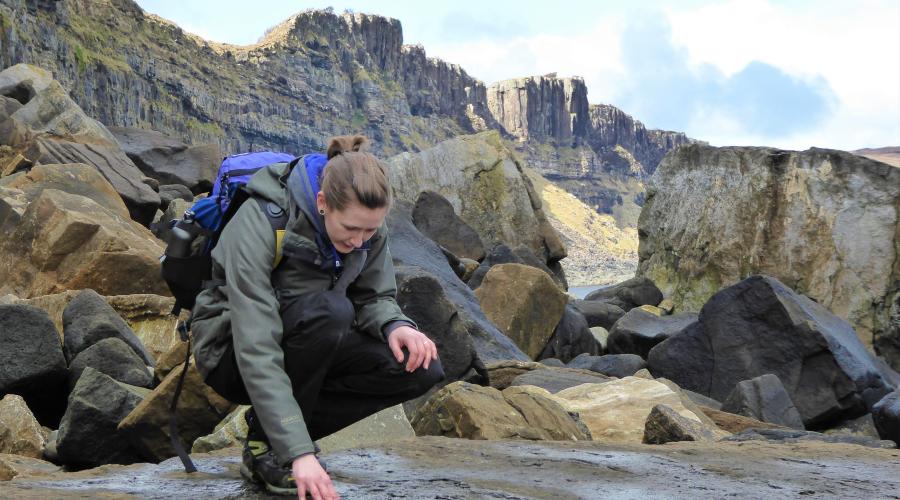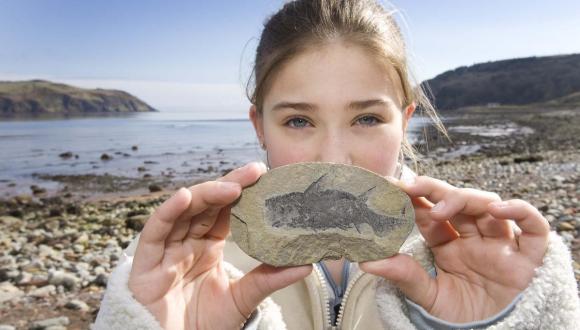
Refreshed Fossil Code celebrates Scotland's female fossil pioneers
9 August 2023
NatureScot has today published the refreshed Scottish Fossil Code, which encourages people to use Scotland’s world-renowned fossil heritage responsibly.
First published in 2008, the Scottish Fossil Code sets out guidance on how to collect and look after fossils in a responsible way, without damaging them or the areas where they are found.
Described as a ‘can-do’ guide to responsible fossil collecting, the refreshed code aims to encourage and enable responsible discoveries, leading to wider public interest and participation. By following the code, people can stay within the law and use best practice in collecting and storing fossils.
To mark its launch, Scotland’s nature agency is celebrating women of past and present with a significant role in the research and discovery of fossils. By sharing the stories of Scotland’s female fossil pioneers, NatureScot hopes to inspire future generations to find out about Scotland’s geology, and deep history, which has relevance in tackling the nature-climate emergency facing us today.
Welcoming the refreshed Scottish Fossil Code, Dr Katie Strang, Director of the Scottish Geology Festival and Research Affiliate at The Hunterian, Glasgow, said:
“Scotland has been witness to some of the most pivotal moments in the evolution of life on Earth and its remarkable fossil record provides a tangible connection to our geological past. Scotland’s fossils inspire curiosity by bringing together a world of science, art and imagination, encouraging people of all ages to learn more about the natural world.
“Palaeontology is for everyone, and by highlighting the important role of women in Scottish palaeontology I hope we can encourage others to follow their passion for discovery and spark an interest in our diverse fossil heritage. The Scottish Fossil Code enables us to safeguard this rich resource and ensure it can continue to reveal our planet’s secrets for years to come.”
Men are well documented and credited for their part in the research and discovery of Scotland’s rich fossil heritage, with Hugh Miller widely recognised as Scotland’s most famous 19th century fossil collector.
However, lesser known but important figures in Scottish palaeontology include fossil collecting pioneers such as Elizabeth Gray (1831-1924) and Eliza Maria Gordon-Cumming (1795-1842) and fossil illustrators such as Phoebe Anna Traquair (1852-1936).
One of the most prolific and skilled female fossil collectors of her time, Elizabeth Gray, created collections for several museums including the Natural History Museum and The Hunterian in Glasgow. Renowned for her extensive collecting in the Girvan area, which she did until the age of 92, Elizabeth was made an honorary member of the Natural History Society of Glasgow in 1901.
Eliza Maria Gordon-Cumming collected and studied fish fossils from the Old Red Sandstone of Morayshire dating from the Devonian age. She amassed a large and well-known collection, which she illustrated along with her daughter, Lady Anne Seymour.
As one of Scotland’s first professional female artists, Pheobe Anna Traquair, prepared detailed fossil fish illustrations for her palaeontologist husband, Ramsay Traquair. Her illustrations featured in his research papers and these drawings are held in the special library collections of National Museums Scotland.
Also leading the way for women in Scottish palaeontology today is Dr Elsa Panciroli, Associate Researcher at National Museums Scotland, Leverhulme Research Fellow at the University of Oxford, and trustee of the Scottish Geology Trust. Elsa said:
“I’m lucky to be able to study Scotland’s fossils as part of my job. The inspiring female fossil collectors of the past couldn’t officially study the specimens they found, because scientific careers were effectively closed to women. Their contributions were nonetheless foundational to palaeontology, and deserve to be recognised.
“Growing up in the Scottish Highlands, I loved looking at rocks, but I had no idea that there were any fossils so close to home. Now with the internet people know where to find them, but may not know how to search in a way that protects our geological heritage – the fossil code provides this information.”
Elsa is part of a research team finding and studying Middle Jurassic material from the Isle of Skye, including mammals, salamanders and dinosaurs. Katie’s current research focuses on using coprolites (fossil poo) to better understand early Carboniferous freshwater ecosystems.
As well as carrying out extensive research, Elsa and Katie are both active in encouraging and broadening participation in science. Elsa has written two popular science books on fossils and evolution, both featuring Scottish fossils, and she has written for newspapers and magazines and delivers regular public talks. Katie provides outreach education for schools, offers guided fossil hunting walks and runs the social media page @scottishfossils on Instagram.
Biodiversity Minister Lorna Slater said:
“Fossils are a window through which scientists can see and understand what Earth was like millions of years ago. They provide clues as to how animal and plant life evolved over the millennia and studying them may unlock solutions to the climate and nature emergencies that we face today. The updated Fossil Code is an important step in ensuring that these valuable artifacts are handled with the utmost care.
“It is welcome news that the women who played vital roles in unlocking the mysteries of the past are finally getting the recognition that they deserve. Their contribution to our understanding of Scotland’s natural history and geology is extensive and should be celebrated at every opportunity.
“I hope that these brave pioneers encourage more women and girls to get involved in these crucial areas of research.”
Eileen Stuart, NatureScot’s Deputy Director of Nature and Climate Change, said:
“Fossils tell us the story of how life has evolved and adapted to past environmental change, and can help us anticipate changes in the future, which has never been more important as we face the twin crises of climate change and biodiversity loss.
“By shining a spotlight on the important role of women in Scotland’s rich fossil heritage, we can inspire others to take up the collection, care and research of fossils too. We encourage everyone with an interest in fossils to follow the Scottish Fossil Code. By ensuring its responsible use, our irreplaceable fossil heritage will continue to be of value for research, education, geotourism and recreational collecting for generations to come.”





